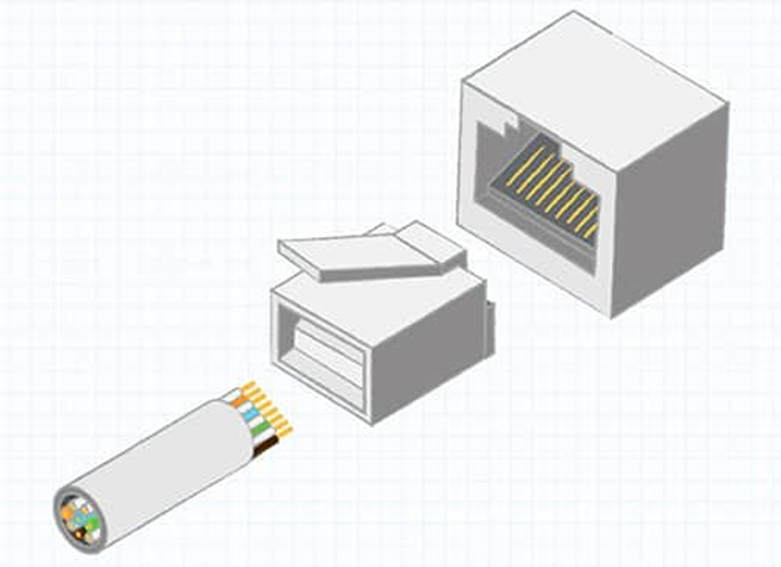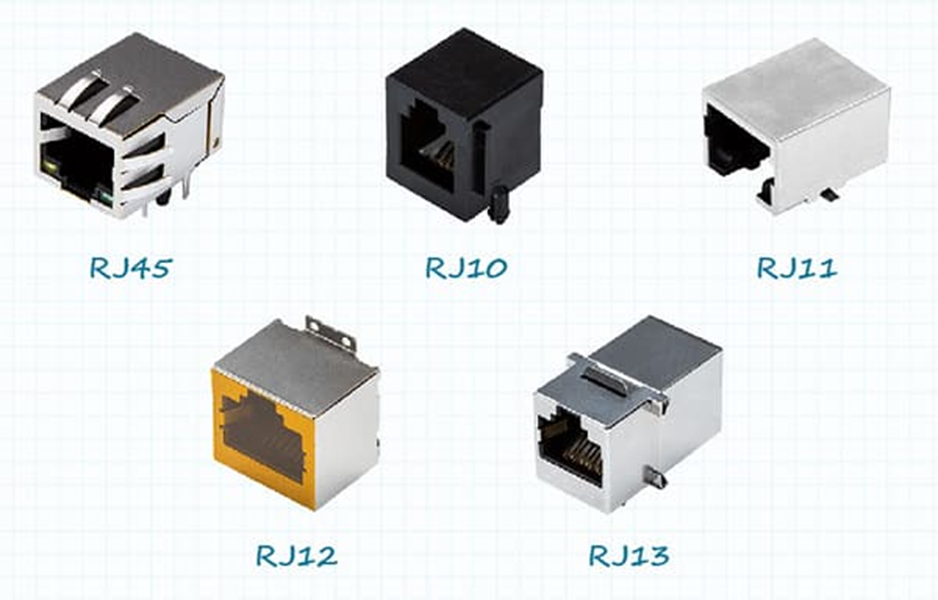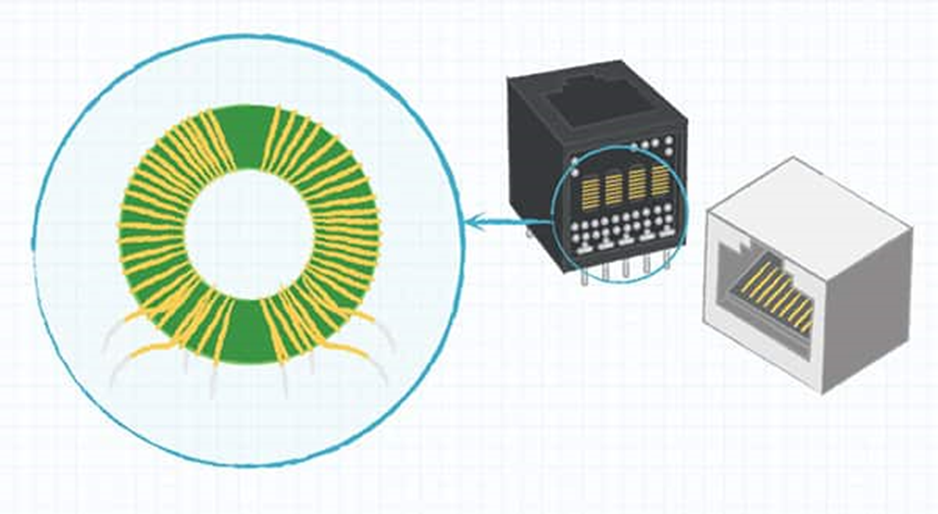RJ Connector:Type, Structure and Parameter
2025-04-02 10:14:41 1673
Since AT&T first introduced modular connectors, also known as RJ connectors, in the 1960s, they have been widely used in telecom and datacom applications. In order to create what is now known as the Registered Jack (RJ) registration system, which standardizes the wire pattern, signaling characteristics, and physical structure of the connector itself, the Federal Communications Commission (FCC) further standardized this interconnect solution in the 1970s. In order to accommodate variations in connection packaging and intended use, users are still accustomed to seeing the naming scheme of "RJ" followed by two digits.
Fundamental Building
Modular or RJ connectors provide a more "modular" and economical connection system for home and commercial phone systems by enclosing stamped metal terminals in a molded shell that is divided by insulated channels. The plastic shell of the plug secures the cable in place to reduce stress, and contacts on the plug engage with corresponding stamped metal contacts in the jack, guided into place by insulated channels. A molded component in the plug and jack that includes an inset spring that clicks into a molded groove in the jack to secure it in place helps to further reduce stress. This spring can be depressed to release the plug from the jack.

Figure 1: An RJ socket mates with a modular plug that has a plastic shell that keeps the cable in place. (Image courtesy of CUI Devices)
Although they are occasionally left empty, modular connectors can be ordered with two, four, six, eight, or ten contact places. For instance, Ethernet (RJ45) connectors contain eight connections, whereas RJ11 telephone connectors usually have four or six. connection wiring is determined by the standard naming scheme; for example, a 6P2C connection has six places and two contacts, but a 4P4C connector for phone lines has four positions and four contacts. RJ connection contacts can supply low-voltage AC or DC power, even though they are mostly used for signaling.
Modular connectors have a lot of advantages. The following are some benefits of these connectors for product manufacturers:
Low price
increased utilization
assembly without solder
Simple personalization
Jacks for surface mounting
sturdy versions for use in industrial settings
Given the following benefits, modular connections are perfect for on-site maintenance and installation jobs.
Easily upgrade or swap out outdated connectors
Simple tools and easy field assembly
Cable assemblies are possible to be altered on location.
Many options for connectors and cabling
Basic instruction for field service employees
The ease of use of the connection insertion/withdrawal action in both situations enables users to address issues more quickly and minimizes service calls.
Typical Types
Modular connections tailored to specific applications are widely available. The most popular varieties and their characteristics are shown below.
RJ10: A straightforward 4P4C rectangular phone handset connector
RJ11 is a square connection (6P2C or 6P4C) that connects a modem to a phone line.
Similar in size to RJ11, but with a 6P6CDEC MMP/MMJ connector, RJ12 is a scaled-down RJ11/12 connector designed to be used with equipment made by Digital Equipment Corporation.
Similar to RJ12 but having a post wire circuit is RJ13 - 6P4C.
Two circuits on RJ14 - 6P4C can be used to connect two phones or modems.
In large telephone systems, the RJ21 modular connector may link up to 25 circuits with up to 50 contacts.
RJ22: a connector that resembles RJ11 but has 4P4C; usually used to connect cell phones
Similar to RJ11 but able to connect up to three devices is RJ25 - 6P6C. RJ45, 8P8C or 8P10C, is an Ethernet LAN connector. For further information, see the blog post "The Ultimate Guide to RJ45 Connectors" from CUI Devices.
Similar to RJ45, RJ48 - 8P8C is used to connect shielded cable to T1 data lines.

Figure 2: Illustrations of typical modular connector kinds. (Photo courtesy of CUI Devices)
Important connector attributes and specifications
Modular connectors can have extra features added to them, like shielding to prevent radio frequency interference (RFI) and electromagnetic interference (EMI) in longer cables. RJ45 and RJ48 shielded connectors are quite popular and are used to extend the shield braid of a cable's ground connection to the mounting panel.
A tab on keyed, certified RJ45 connections keeps the connector from inadvertently being put into the socket. This functionality is typically absent from standard 8P8C connectors. Which cables are compatible with a specific network connection point can be identified by color coding.
There are typically several mounting options available, including surface mount to PCB, through-hole, panel mount, and circuit board mount. Jacks that are modular can be oriented horizontally or vertically.
Features for displays and indications, including status LEDs that change color.
High reliability variations: ruggedized components, unique keying, protective sleeves, and EMI/RFI shielding are a few examples. There are more insertion/extraction operations as a result of all these features.
xBASE-T networks with integrated magnets for enhanced EMI shielding performance and connection dependability. These are wire-wound parts in the jack that offer isolation, signal balance, and impedance matching in addition to preventing transients.

Modular connectors with built-in magnets for enhanced EMI shielding and connection dependability are shown in Figure 3. (Image courtesy of CUI Devices)
Extra Parameters
When choosing the ideal modular connector for a given application, the following factors must also be taken into account:
Pin layout refers to how each contact in a connection is assigned.
The maximum current that the device can handle is indicated by its current rating.
The highest operational voltage that a gadget can tolerate is known as its voltage rating.
The greatest diameter wire that the connector can accept is indicated by the contact size.
There are always an even number of contacts.
Summary
Despite being standardized over 40 years ago, modular connectors continue to be widely used because to their many uses, ease of use, and high availability. Although phone systems, data networks, and low-speed serial connections are the main applications for these connectors, Power over Ethernet (PoE) development and its general flexibility have led to a further increase in their use. Modular connectors are used in many designs nowadays, including development boards, motion control, industrial control, and smart lighting.
Although RJ Series modular connectors are widely used, not all of them are made equally. It is possible to guarantee that engineers specify the appropriate RJ connectors and jacks for their application by discussing the aforementioned aspects with your supplier. The modular connection collection from CUI Devices comes with a variety of locations, contacts, and mounting choices and is available in RJ10, RJ11, RJ12, RJ13, and RJ45 jack types.




